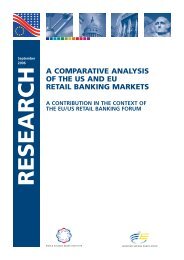Corporate Governance and Access to Finance - ESBG
Corporate Governance and Access to Finance - ESBG
Corporate Governance and Access to Finance - ESBG
You also want an ePaper? Increase the reach of your titles
YUMPU automatically turns print PDFs into web optimized ePapers that Google loves.
B. SENIOR MANAGEMENTPrinciple 5 Under the direction of the board, senior management should ensurethat the bank’s activities are consistent with the business strategy,risk <strong>to</strong>lerance/appetite <strong>and</strong> policies approved by the board.C. RISK MANAGEMENT AND INTERNAL CONTROLSPrinciple 6 Banks should have an effective internal controls system <strong>and</strong> a riskmanagement function (including a chief risk officer or equivalent) withsufficient authority, stature, independence, resources <strong>and</strong> access <strong>to</strong>the board.Principle 7 Risks should be identified <strong>and</strong> moni<strong>to</strong>red on an ongoing firm-wide<strong>and</strong> individual entity basis, <strong>and</strong> the sophistication of the bank’s riskmanagement <strong>and</strong> internal control infrastructures should keep pacewith any changes <strong>to</strong> the bank’s risk profile (including its growth),<strong>and</strong> <strong>to</strong> the external risk l<strong>and</strong>scape.Principle 8 Effective risk management requires robust internal communicationwithin the bank about risk, both across the organisation <strong>and</strong> throughreporting <strong>to</strong> the board <strong>and</strong> senior management.Principle 9 The board <strong>and</strong> senior management should effectively utilise the workconducted by internal audit functions, external audi<strong>to</strong>rs <strong>and</strong> internalcontrol functions.D. COMPENSATIONPrinciple 10 The board should actively oversee the compensation system’s design<strong>and</strong> operation, <strong>and</strong> should moni<strong>to</strong>r <strong>and</strong> review the compensationsystem <strong>to</strong> ensure that it operates as intendedPrinciple 11 An employee’s compensation should be effectively aligned withprudent risk taking: compensation should be adjusted for all types ofrisk; compensation outcomes should be symmetric with risk outcomes;compensation payout schedules should be sensitive <strong>to</strong> the time horizonof risks; <strong>and</strong> the mix of cash, equity <strong>and</strong> other forms of compensationshould be consistent with risk alignment.E. COMPLEX OR OPAQUE CORPORATE STRUCTURESPrinciple 12 The board <strong>and</strong> senior management should know <strong>and</strong> underst<strong>and</strong>the bank’s operational structure <strong>and</strong> the risks that it poses(ie “know-your-structure”).Principle 13 Where a bank operates through special-purpose or related structuresor in jurisdictions that impede transparency or do not meetinternational banking st<strong>and</strong>ards, its board <strong>and</strong> senior managementshould underst<strong>and</strong> the purpose, structure <strong>and</strong> unique risks of theseoperations. They should also seek <strong>to</strong> mitigate the risks identified(ie “underst<strong>and</strong>-your-structure”).58
















